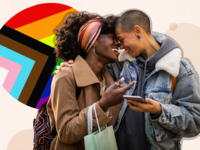Everything You Need to Know About Being Polysexual (But Didn't Want to Ask)

Whether you're in a long-term relationship or diving into a new one or are comfortably single, learning ways to describe your own sexuality can be beneficial and even therapeutic. Moreover, educating oneself on the various spectrums of the LGBTQIA+ community is always a good idea. Polysexual, for example, is one way you, a partner or a friend may identify.
To get a clearer understanding of what this may mean, we spoke to mental health counselor Rachel Damin, LMHC, of Rachel Damin Psychotherapy, a New York City-based therapy practice.
Below, learn the definition of polysexual and how it differs from other branches of the LGBTQIA+ community tree.
In this article:
- What Does Polysexual Mean?
- Polysexual vs. Pansexual
- Polysexual vs. Bisexual
- Polysexual vs. Polyamorous
- How to Know If You're Polysexual
- How to Be an Ally to the Polysexual Community
What Does Polysexual Mean?
Polysexual is a type of sexuality, like bisexuality or pansexuality—though these terms are not interchangable.
According to GLAAD, a polysexual individual "has the capacity to form enduring physical, romantic and/ or emotional attractions to a range of people of various—but not necessarily all—genders."
To break it down further, think of it like this: The root of polysexual is the Greek prefix poly-, translating to 'many' or 'much.'
But remember: Being polysexual is not the same as being bisexual or polysexual or a polyamorous relationship, other commonly confused terminology you may or may not be familiar with.
Polysexual vs. Pansexual
Let's get back to that whole root word thing: Pan- means 'all.' So a pansexual person is one who is attracted to all genders; while a polysexual person, as a reminder, can be attracted to many—but not all—genders.
For reference, GLAAD defines pansexuality as, "a person who has the capacity to form enduring physical, romantic, and/ or emotional attractions to people of all genders or to people regardless of gender."
Polysexual vs. Bisexual
According to GLAAD, the bisexual term can really encompass all terms "for people with the capacity to be attracted to more than one gender." Someone may also identify as bisexual if they are attracted to two or more gender identities.
Polysexual vs. Polyamorous
While polysexuality is a sexual identity, being polyamorous is a way of framing a relationship; with polyamoury being a relationship style.
To clarify and, possibly clear up any common misconceptions, "a polysexual person can definitely be in a monogamous relationship," adds Rachel Damin, LMHC.
How to Know If You're Polysexual
"Most people have a felt sense about their sexuality, whether it's from a very young age or if it's something that develops over time," Damin says. "We kind of recognize patterns in where our attraction lies."
"People also sometimes come to therapy to figure these things out," notes Damin, who explains that a licensed therapist can help a client explore their sexuality if desired and assist in untangling (and better understanding) certain thoughts and feelings surrounding gender and sexuality, both in and out of the context of relationships.
How to Be an Ally to the Polysexual Community
One of the best ways to be an ally to the polysexual community is by remaining open and curious—not judgemental, as Damin points out—about different sexualities and relationship structures. If you have a friend who identifies as polysexual, pansexual, or bisexual or is in a polyamorous relationship, for example, "don't assume that looks a certain way or has defined parameters," says Damin.
Moreover, try your best to stand up for polysexual inclusion even in the absence of polysexual people.























